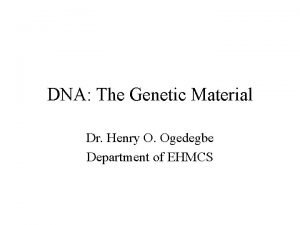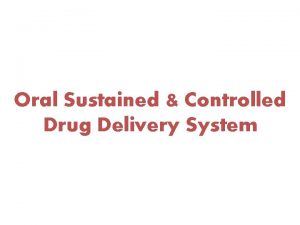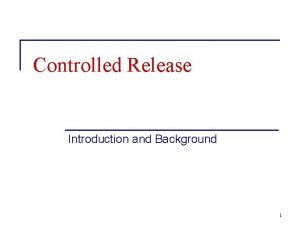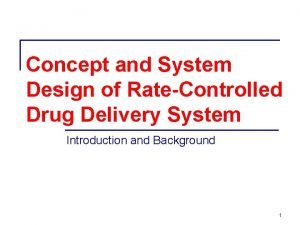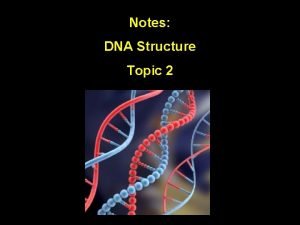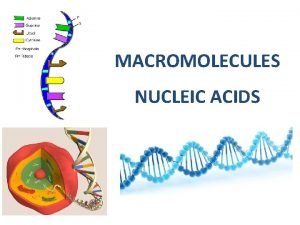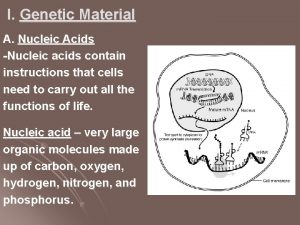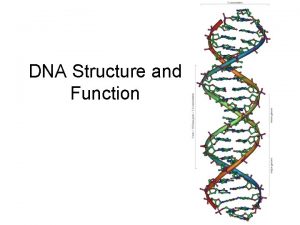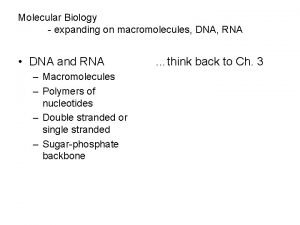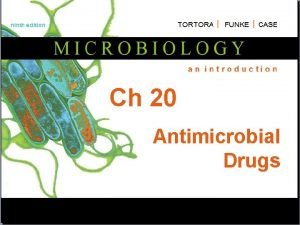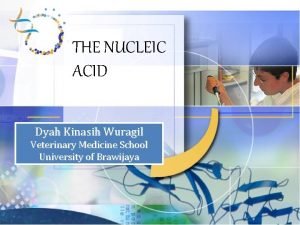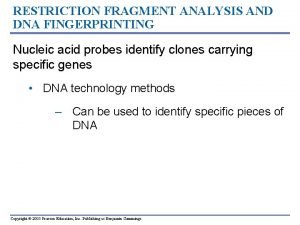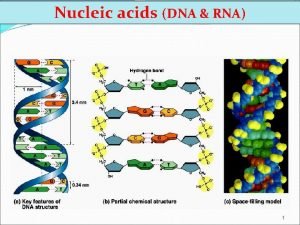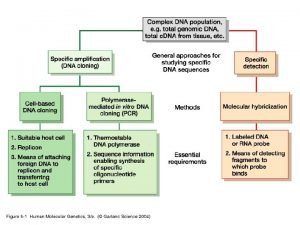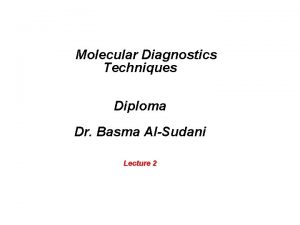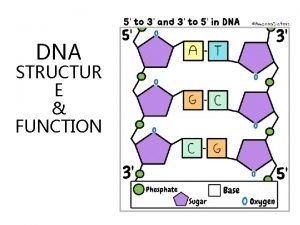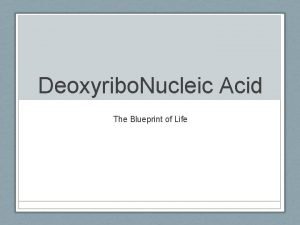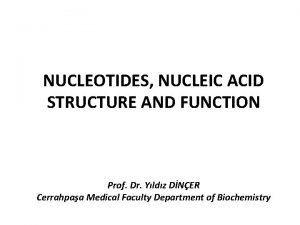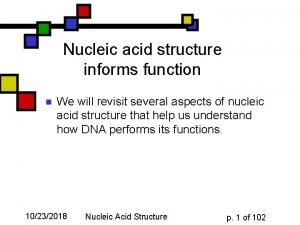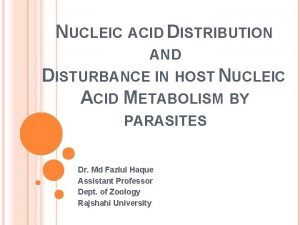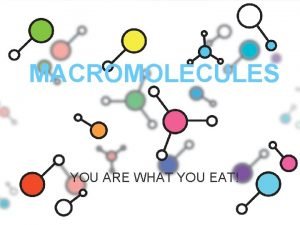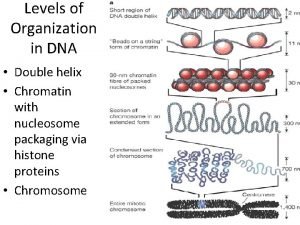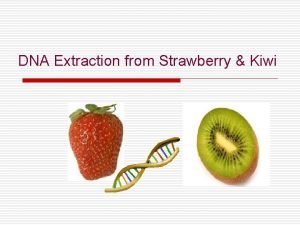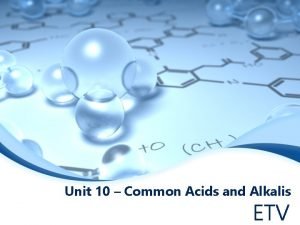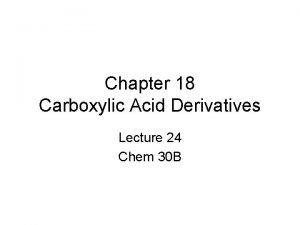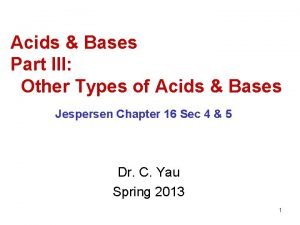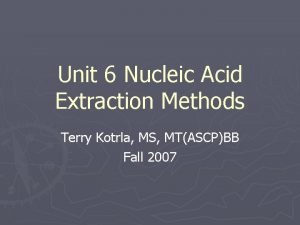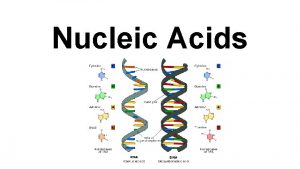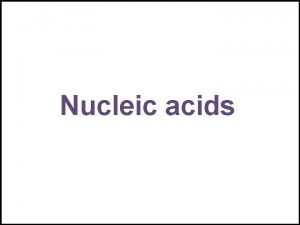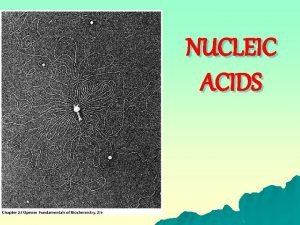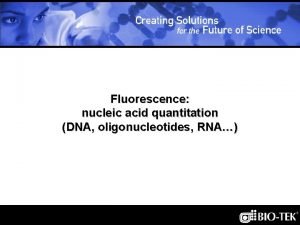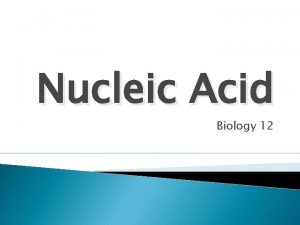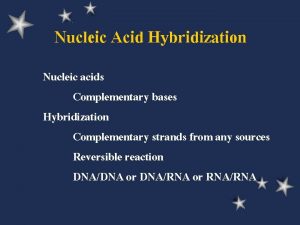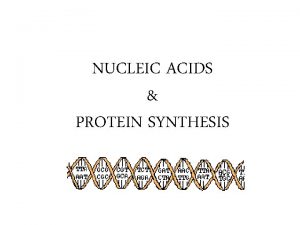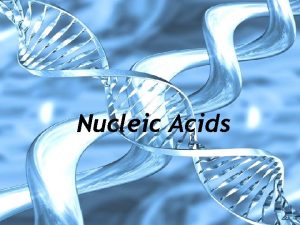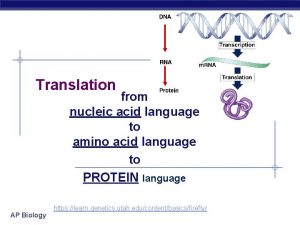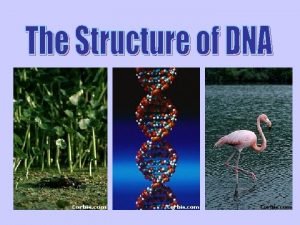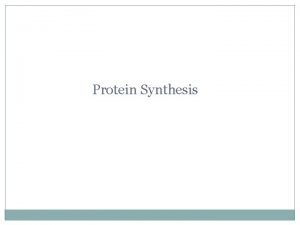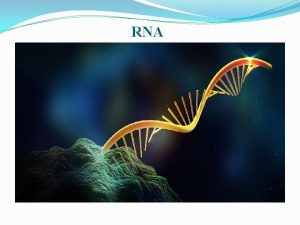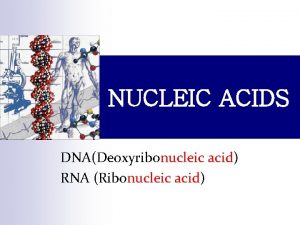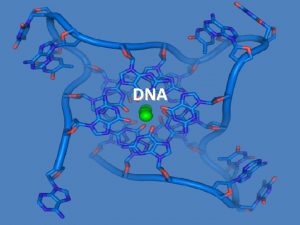NUCLEIC ACID EXTRACTION METHODS Purpose To release nucleic







































- Slides: 39

NUCLEIC ACID EXTRACTION METHODS

Purpose To release nucleic acid from the cell for use in other procedures Must be free from contamination with protein, carbohydrate, lipids or other nucleic acids. Used pure nucleic acids for testing.

Principles for Handling of All Clinical Specimens Observe universal precautions for biohazards. Use protective gowns, gloves, face and eye shields. Decontaminate all spills and work areas with 10% bleach. Dispose of all waste in appropriate biologic waste containers. Use gloves. Your RNA depends on it!

Types of Specimens for the Molecular Diagnostics Laboratory Whole blood Bone marrow PBSC (phoresis product) Serum/plasma Buccal cells Cultured cells Blood spots Body fluids CSF Amniotic Semen Urine Tissue samples Fresh/frozen Paraffin-embedded Hair

Fundamentals of Specimen Handling: Specimen Labeling Patient name, date of birth, and medical record number Ordering physician Type of specimen Accession number Date and time of collection Laboratory technician identification (initials) Requested test(s)

Blood and Bone Marrow Isolation of nucleic acids Genomic DNA RNA Collection: Collect in an anticoagulant, mix well but gently to avoid disruption of cells

Anticoagulants EDTA Preferred specimen ACD (Acid Citrate Dextrose) Yellow-top Vacutainer Heparin Green-top Vacutainer Inhibits several enzymes used in molecular assays

Specimen Packaging and Shipping: DO NOT FREEZE!!! Protect from temperature extremes Packaging must comply with shipping rules for bloodborne pathogens Protective container Absorbent material in packing Sealed container in plastic bag Labeled as Biohazard

Nucleic Acid Preparation Application? DNA Amplification methods (PCR) Restriction enzyme digest Hybridization methods (Southern analysis) Sequencing

Nucleic Acid Storage Requirements: Storage of DNA Specimens <4 Months 1– 3 Years <7 Years >7 Years 2– 25 °C 2– 8 °C – 20 °C – 70 °C Recommended for long-term storage

Nucleic Acid Preparation Application? RNA Amplification methods (RT-PCR) Hybridization methods (Northern analysis)

Nucleic Acid Preparation Other Considerations What is the size or volume of each sample? Amount of DNA or RNA required Equipment and tube sizes required How many samples are being processed? Capacity of the centrifuge Isolation method speed Is an automated system available? 96 -well plate methods Walk-away or semi-automation

Nucleic Acid Preparation Choosing an Isolation Method Important factors are: Processing speed Ease of use Yield of DNA or RNA Quality of DNA and RNA prepared (amplification performance) Shelf life/storage conditions Cost of preparation

Isolation Routinely isolated from human, fungal, bacterial and viral sources. Pretreat to make nucleated cells available, whole blood Tissue samples Microorganisms Need sufficient sample for adequate yield.

Organic Isolation Must purify DNA by removing contaminants. Accomplished by using combination of high salt and an organic mixture of phenol and chloroform. To avoid RNA contamination add RNAse, enzyme that degrades RNA.

Phenol/Chloroform Biphasic Hydrophobic layer on bottom has cell debris. Hydrophilic layer on top has dissolved DNA Remove top layer, add cold ethanol, DNA precipitates out.

Inorganic Isolation Methods Also called “salting out”. 1. Uses low p. H and high salt condition to selectively precipitate proteins. DNA is left in solution (picture on left). 2. Precipitate out DNA with isopropanol (right side picture). 2 1

Solid Phase Isolation More rapid and effective Use solid matrix to bind the DNA. Wash away contaminants. Elute DNA from column

Solid Phase Isolation cont…. . The diagram below explains the attractive properties of solid phase for DNA and RNA. DNA/RNA hydrophilic……. . Absorb Lipids/protiens……. Hydrophobic……wash away

Isolation of Mitochondrial DNA is passed from generation to generation along the maternal lineage. Centrifugation to separate out Lyse Precipitate with cold ethanol.

Nuclear DNA Present in almost every cell Combination from both parents; 23 chromosomes from each parent

Mitochondrial DNA Each cell contains thousands of mt, each containing copies of its DNA Mt DNA is in larger quantities in a cell Nuclear DNA is larger in size

Mt DNA is 16, 569 bases in length and consists of 2 different regions Coding Region Produces 13 proteins, 22 t. RNAs 2 r. RNAs This region has very little variability So everyone’s DNA in this region will be nearly the same sequence of TGCAs

Human Mitochondrial Genome Human mt. DNA composes of a control region (CR)

Control Region This region is highly variable within the human population Consists of 2 subregions HV 1 = 342 bp HV 2 = 268

Mutations occur in the control region of mt

We can compare DNA from the controlling region to other living humans See how related to you are to each other Compare to prehistoric remains of human fossils Identify where you DNA originated Identify ancestral relationships between modern populations Compare your highly variable regions to other species

1. Isolate DNA from cheek cells 2. Complete a PCR reaction Produce millions of extra copies of HV 1 on the control region of mt. DNA 3. Send amplified DNA away to be sequenced (Identify the exact sequence of TGCAs in HV 1 in your mt. DNA) 4. Compare your sequence …… prehistoric DNA


Isolation of RNA Requires STRICT precautions to avoid sample degradation.

RNAses RNases are naturally occurring enzymes that degrade RNA Common laboratory contaminant (from bacterial and human sources) Also released from cellular compartments during isolation of RNA from biological samples Can be difficult to inactivate

RNAses cont…… RNAses are enzymes which are small proteins that can renature and become active. MUST be eliminated or inactivated BEFORE isolation. CRITICAL to have a separate RNAse free area of lab.

Protecting Against RNAse Wear gloves at all times Use RNase-free tubes and pipet tips Use dedicated, RNase-free, chemicals Pre-treat materials with extended heat (180 C for several hours), wash with DEPC-treated water (Di ethyl pyro carbonate) Supplement reactions with RNase inhibitors

Total RNA 80 -90% of total RNA is ribosomal RNA. 2. 5 -5% is messenger RNA

Organic RNA Extraction 1. Lyse/ 2. Add pheno alcoho centrif 3. Organ aqueo Org Aqu tota Cellu appe inte

Types of nucleic acid Viral RNA Bacterial RNA Genomic RNA Viral DNA Bacterial DNA Genomic DNA Plasmid mitochondrial


TRI Reagent combines phenol and guanidine thiocyanate in a mono- phase solution to facilitate the immediate and most effective inhibition of RNase activity. A biological sample is homogenized or lysed in TRI Reagent. guanidinium isothiocyanate powerful protein denaturant) RNA is stable in trizol which deactivates RNases. Chloroform causes proteins to become denatured and become soluble in the organic phase or interphase, while nucleic acids remain in the aqueous phase.

Isopropanol RNA is insoluble in isopropanol so it will aggregate together, giving a pellet upon centrifugation. This step also removes alcohol-soluble salt.
 Significance of nucleic acid
Significance of nucleic acid Nature of nucleic acid
Nature of nucleic acid Sustained release definition
Sustained release definition Osmotic pump
Osmotic pump Extended release vs sustained release
Extended release vs sustained release Is dna a nucleic acid
Is dna a nucleic acid Nucleic acids monomers building blocks
Nucleic acids monomers building blocks 4 macromolecules
4 macromolecules Nucleic acid made up of
Nucleic acid made up of Polymer structure of nucleic acids
Polymer structure of nucleic acids Dideoxyribonucleic
Dideoxyribonucleic Gastric glands
Gastric glands Colony hybridization
Colony hybridization Ribonucleotide vs deoxyribonucleotide
Ribonucleotide vs deoxyribonucleotide Nucleic acid chart
Nucleic acid chart Clindamycin metabolism
Clindamycin metabolism Nucleic acid monomer
Nucleic acid monomer Nucleic acid test
Nucleic acid test Infectious nucleic acid
Infectious nucleic acid Nucleic acid
Nucleic acid Nucleic acid
Nucleic acid Phosphodiester bond
Phosphodiester bond Nucleic acid
Nucleic acid Types of nucleic acid
Types of nucleic acid Chargaff rule definition
Chargaff rule definition Nucleic acid
Nucleic acid Nucleic acid dna structure
Nucleic acid dna structure Biologically important nucleotides
Biologically important nucleotides Nucleic acid
Nucleic acid Function of nucleic acids
Function of nucleic acids Biological molecules you are what you eat
Biological molecules you are what you eat Secondary structure of dna
Secondary structure of dna Serial extraction sequence
Serial extraction sequence Kiwi dna extraction
Kiwi dna extraction A-wax pattern recognition
A-wax pattern recognition 9-which acid is not considered a strong acid?
9-which acid is not considered a strong acid? Example of acid-fast bacteria
Example of acid-fast bacteria Alcohol and anhydride reaction
Alcohol and anhydride reaction Example of acid-fast bacteria
Example of acid-fast bacteria Lewis acid vs bronsted acid
Lewis acid vs bronsted acid

